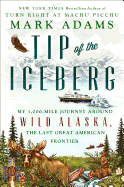
A little closer to home than his popular Turn Right at Machu Picchu, Mark Adams's Tip of the Iceberg takes place in Alaska and follows in the footsteps of John Muir et al. on the 1899 scientific expedition financed by railroad tycoon Edward H. Harriman. It is both the amusing travelogue of a city dude rolling his first kayak and a sound history based on Muir's journals, Aleut artifacts, a little geography and geology, and ample quirky statistics.
The hero of Adams's tale is Alaska itself--"essentially a small continent." Its acquisition by the United States from Russia in 1867 was tagged "Seward's Folly," which was a raw deal for Seward. As Adams demonstrates with wit and insight, it might better be called "Seward's Steal" if measured only in natural beauty. As he makes his way up the Inside Passage a century after the Harriman expedition, he finds the same stunning geography as those early explorers, scientists and naturalists did.
The state's economy has always been boom-and-bust, in what Adams calls its three gold rushes: first it was stripped of game by fur traders, then came the Yukon gold rush and, finally, the Alaska pipeline tapped its vast oil reserve in Prudhoe Bay. But the latter is running dry.
An easy-going conversationalist, Adams chats with a cross-section of Alaskans, including his Glacier Bay guide who runs off two threatening brown bears. The "sourdough" guide reminds Adams, "You can be in awe of the beauty, but you have to remember that things can go from 'Ooh, ahh!' to 'Oh, sh*t!' in an instant." That might be as good a summary of Alaska as any. --Bruce Jacobs, founding partner, Watermark Books & Cafe, Wichita, Kan.

